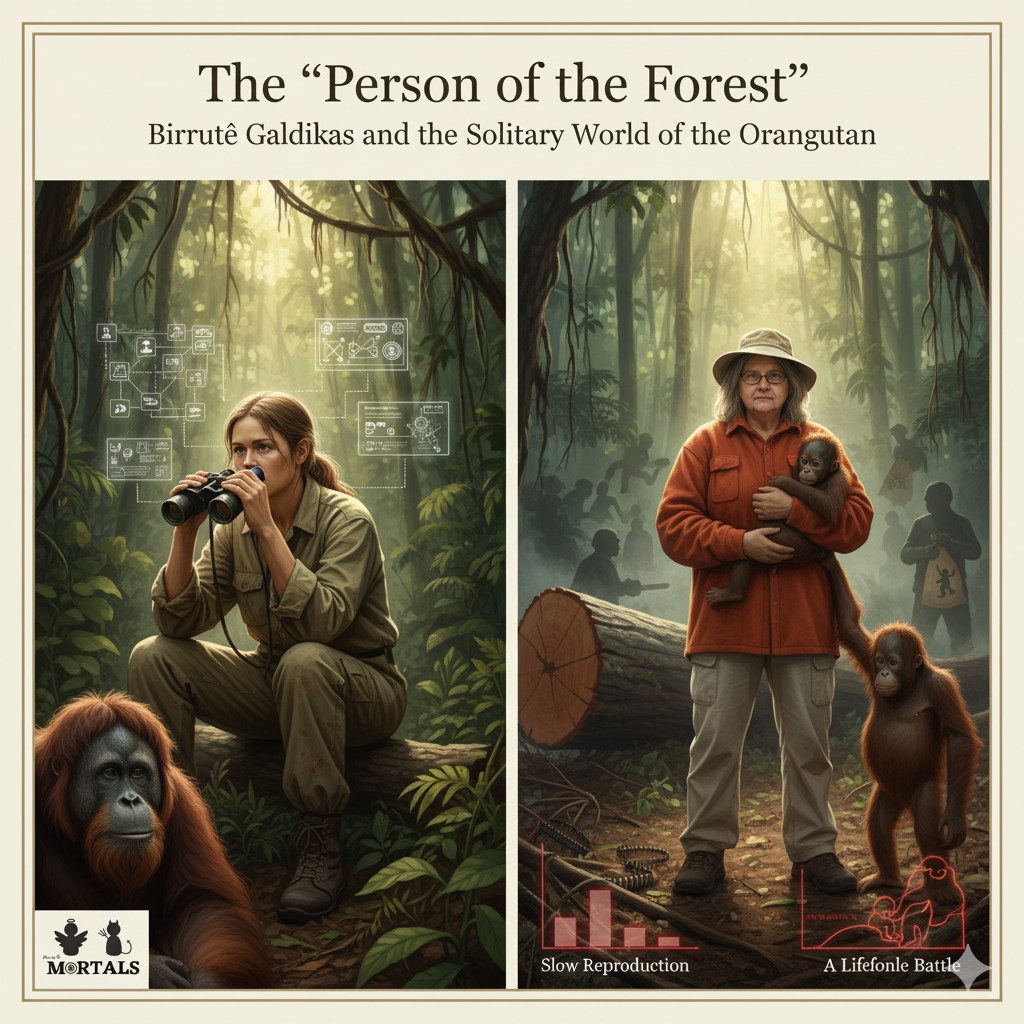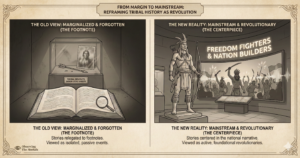The story of “Leakey’s Angels,” the trio of pioneering female primatologists mentored by Louis Leakey, has a third, equally important, and profoundly dedicated chapter. After Jane Goodall went to study the chimpanzees and Dian Fossey the gorillas, a young Lithuanian-Canadian scientist named Birutė Galdikas took on what was perhaps the most difficult challenge of all: to study the elusive, solitary, and tree-dwelling “person of the forest”—the orangutan. Her journey into the dense rainforests of Borneo would become one of the longest continuous studies of any mammal in the world, a story of incredible patience, groundbreaking discoveries, and a lifelong battle against the chainsaws and poachers threatening to wipe them out.
The Information Box
Syllabus Connection:
- Paper 1: Chapter 1.5 (Primate Behaviour: Orangutans), Chapter 1.4 (Human Evolution), Chapter 1.8 (Fieldwork Traditions)
Key Concepts/Tags:
- Birutė Galdikas, Orangutans, Primatology, Conservation, The Trimates, Solitary Apes, Borneo
The Setting: Who, What, Where?
This is the story of Dr. Birutė Galdikas, the third of “The Trimates.” Her life’s work is detailed in her memoir, Reflections of Eden. In 1971, she traveled to the daunting, leech-infested rainforests of Tanjung Puting National Park in Borneo, Indonesia. There, she established “Camp Leakey,” which would become the base for the longest continuous study of a wild mammal population ever conducted. Her subjects were the shy and critically endangered Bornean orangutans.
The Core Argument: Why Her Work Was Foundational
Galdikas’s research filled in the final, crucial piece of the great ape puzzle and created a new model for conservation.
- Unlocking the Secrets of a Solitary Ape: This is her most significant scientific contribution. While chimpanzees and gorillas live in complex social groups, orangutans are largely semi-solitary. Galdikas’s decades of painstaking observation provided the first detailed picture of their unique social world. She discovered that adult males are solitary wanderers, and the most intense and important social bond is the incredibly long and intimate relationship between a mother and her offspring, which can last for up to eight years.
- Revealing the Slowest Life History: The sheer duration of her study allowed her to document the entire life history of individual orangutans. She revealed their incredibly slow reproductive cycle—a female gives birth only once every eight years, the longest interbirth interval of any great ape. This crucial discovery explained why orangutan populations are so extremely vulnerable to threats; even a small loss of females can have devastating consequences for the species’ survival.
- A Pioneer in Rehabilitation and Conservation: Galdikas’s work very quickly evolved from pure research into hands-on conservation. Confronted with the devastating impact of deforestation and a brutal illegal pet trade (where mothers are killed to capture their infants), she transformed Camp Leakey into a pioneering rehabilitation and rescue center. She became a surrogate mother to dozens of orphaned orangutans, developing methods to teach them the skills needed to survive and eventually return to the wild.
The Anthropologist’s Gaze: A Critical Perspective
- The “Rehabilitation” Dilemma: Like provisioning, the practice of rehabilitating ex-captive apes and reintroducing them into a wild or semi-wild population is methodologically complex. It can risk introducing human diseases into the wild population and can alter the social dynamics and behavior of the truly wild apes. While ethically necessary to save the orphans, it poses a constant challenge to the goal of studying a purely “natural” population.
- The Price of Extreme Immersion: Galdikas’s story, perhaps more than any other, highlights the immense personal sacrifices involved in this kind of long-term fieldwork. She famously raised her own young son in the remote camp alongside the orphaned orangutans, profoundly blurring the lines between observer and participant, and between human family life and scientific mission.
- A Site-Specific Conservation Model: Galdikas’s model of conservation—combining a long-term research station with an active rescue and rehabilitation center that also serves as a hub for ecotourism—is distinct from Goodall’s global ambassadorship or Fossey’s aggressive anti-poaching tactics. It is a deeply hands-on, site-specific model of direct intervention, rescue, and advocacy.
The Exam Angle: How to Use This in Your Mains Answer
- Types of Questions Where It can be Used:
- “Compare and contrast the social organization of the great apes.”
- “Discuss the contributions of primatology to the conservation of endangered species.”
- “Analyze the different methods and ethical challenges in the study of primate behavior.”
- Model Integration:
- On Primate Behavior: “The great apes exhibit a wide diversity of social structures. In stark contrast to the group-living chimpanzees and gorillas, the orangutan is largely semi-solitary, a fact detailed through the unprecedentedly long-term research of Birutė Galdikas. Her work in Borneo revealed that the primary social unit is the long-lasting and intense bond between a mother and her single dependent offspring.”
- On Conservation: “Primatologists have pioneered different models of conservation. While Jane Goodall became a global ambassador, Birutė Galdikas established a pioneering model at Camp Leakey in Borneo that directly combined scientific research with an active rehabilitation center for orphaned orangutans, a direct response to the threats of deforestation and the illegal pet trade.”
- To show comparative knowledge: “The work of Louis Leakey’s ‘Trimates’ provides a comprehensive picture of the great apes. Goodall revealed the complex political society of chimpanzees, Fossey the gentle family life of gorillas, and Galdikas the solitary world and long maternal investment of the orangutans, together revolutionizing our understanding of our closest living relatives.”
Observer’s Take
Birutė Galdikas is the third and final chapter in the incredible story of the Trimates, a testament to what is possible through sheer, unwavering dedication. She took on the most difficult subject of all: an elusive, solitary ape hidden in the formidable rainforests of Borneo, a world away from global attention. Her legacy is one of extraordinary patience and a lifetime of commitment. By dedicating her entire adult life to the “person of the forest,” she not only revealed the secrets of their slow, quiet, and solitary world but also built a sanctuary to protect them from the ravages of the modern one. Her story, completing the powerful trilogy of Goodall and Fossey, stands as a profound monument to long-term, immersive fieldwork and a lifelong promise to not just study, but to actively save, our endangered primate family.





